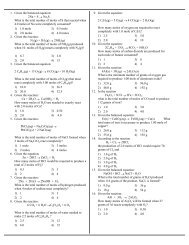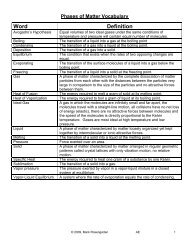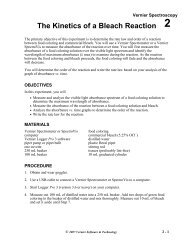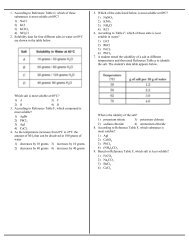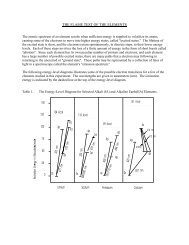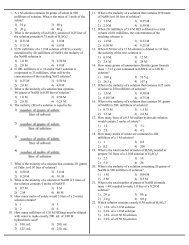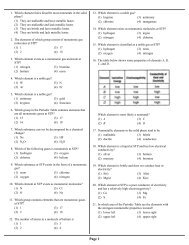Kinetics, Thermodynamics and Equilibrium - Revsworld
Kinetics, Thermodynamics and Equilibrium - Revsworld
Kinetics, Thermodynamics and Equilibrium - Revsworld
You also want an ePaper? Increase the reach of your titles
YUMPU automatically turns print PDFs into web optimized ePapers that Google loves.
3) Determining a Reaction’s ∆S<br />
AE Reference Table B gives the ∆H, ∆G <strong>and</strong> temperature. Using these, we can determine the ∆S by rearranging the<br />
Gibbs equation using simple algebra thusly:<br />
1) Original equation: ∆G = ∆H - T ∆ S<br />
2) adding T ∆ S to each side gives ∆G + T ∆ S = ∆H<br />
3) subtracting ∆G from each side gives T ∆ S = ∆H - ∆G<br />
4) Dividing both sides by T gives ∆ S = (∆H - ∆G)/T<br />
Calculate the ∆S for CO.<br />
∆ S = (∆H - ∆G)/T = [(-110 kJ) – (-137 kJ)] / 298 K = +0.0906 kJ/K.<br />
Because ∆H is negative (favored) <strong>and</strong> ∆S is positive (favored), this reaction will be spontaneous at all temperatures.<br />
Calculate the ∆S for C 2 H 4 .<br />
∆ S = (∆H - ∆G)/T = [(+52 kJ) – (+168 kJ)] / 298 K = -0.39 kJ/K.<br />
Because ∆H is positive (unfavored) <strong>and</strong> ∆S is negative (unfavored), this reaction will never be spontaneous at any<br />
temperature. It will always be nonspontaneous.<br />
Calculate the ∆S for ICl.<br />
∆ S = (∆H - ∆G)/T = [(+18 kJ) – (-5 kJ)] / 298 K = +0.044 kJ/K.<br />
Because ∆H is positive (unfavored) <strong>and</strong> ∆S is positive (favored), this reaction will be spontaneous at temperatures at<br />
which T∆S is larger than ∆H <strong>and</strong> nonspontaneous at temperatures at which T∆S is smaller than ∆H.<br />
4) Determining the temperature at which a reaction becomes spontaneous (<strong>Equilibrium</strong> temperature)<br />
At equilibrium, both the forward <strong>and</strong> reverse reactions are spontaneous, <strong>and</strong> occur at the same rate. ∆G equals 0 at<br />
this temperature, which means that the reaction can go forward or reverse.<br />
1) Original equation: ∆G = ∆H - T ∆ S<br />
2) Set ∆G equal to zero: 0 = ∆H - T ∆ S<br />
3) Add T ∆ S to both sides: T ∆ S = ∆H<br />
4) Divide both sides by ∆S: T = ∆H/∆S<br />
Determine the temperature at which ICl reaches equilibrium.<br />
T = ∆H/∆S = (+18 kJ) / (+0.044 kJ/K) = 410 K<br />
Since ∆S is positive (favored), increasing the temperature will make the reaction more favorable. Therefore, this<br />
reaction is spontaneous at all temperatures above 410 K <strong>and</strong> nonspontaneous at all temperatures below 410 K.<br />
© 2009, Mark Rosengarten AE 18






